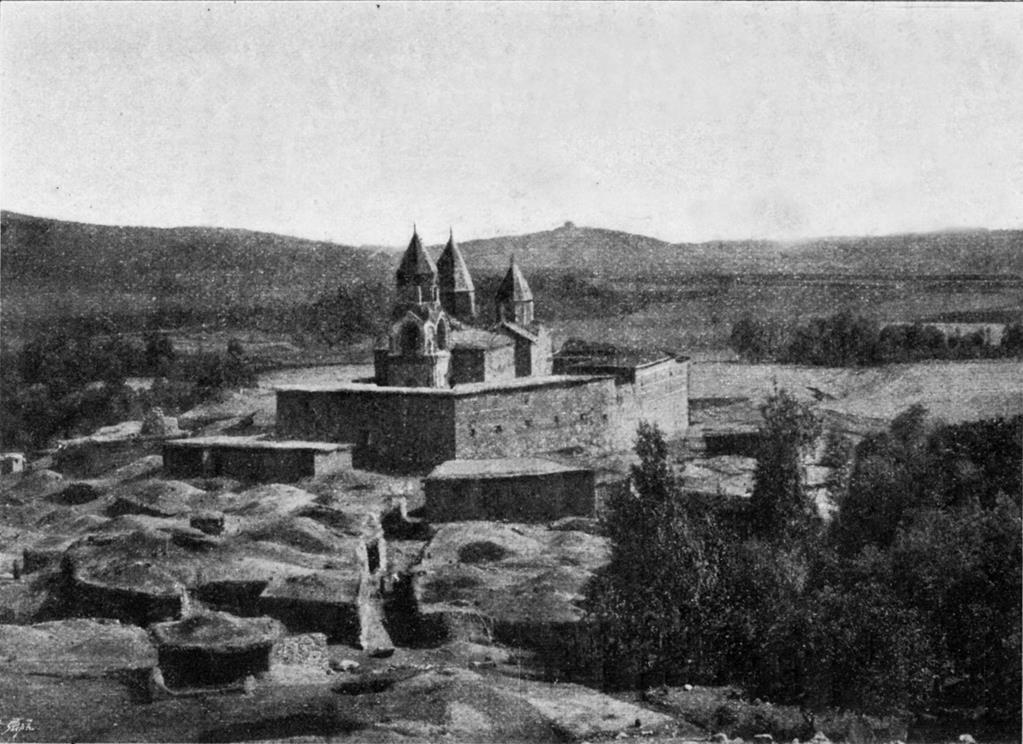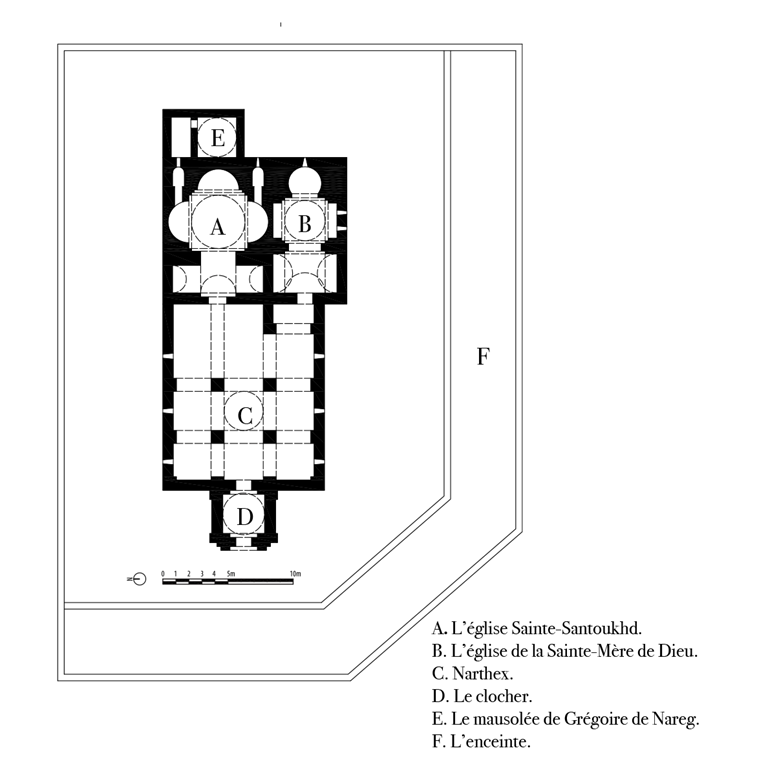This famous monastery lies at 38° 17’ N and 42° 55’ E in the eastern part of the Armenian canton of Rëshdunik‘, southwest of Osdan (or Vosdan) [Gevaş] and at some distance from the southern shore of Lake Van, in the shadow of Mount Egherovn [Agerov Dağ]. It was built in the middle of the village of Nareg (Narek) [Yemişlik], hence its name.
The foundation of the Nareg desert goes back to 925-940. It was established by communities of monks having fled the Chalcedonian persecution in the Byzantine territories and seeking refuge with the Armenian sovereigns. Together with Gamrdchatzor – which has disappeared – and Horomos (n° 82), Nareg is one of the three establishments created by these communities under the rule of Saint Basil. It was under Abbot Anania of Nareg (Anania Naregatsi, † c. 980) that the Nareg community truly began to prosper, giving rise to a school that was to produce a number of brilliant scholars – philosophers as well as poets, musicians, commentators and copyists – once again dedicated to the quest for spirituality and truth. In the wake of Abbot Anania, two brothers among his relations would distinguish themselves, John of Nareg (Hovhannes Naregatsi) and an even more brilliant subject, Gregory of Nareg (Krikor Naregatsi, 940-1003), a mystical poet whom the Armenian Church has classed among its saints; and too the bishop and historian Ukhdanes (935?-1000), one of Anania’s nephews. After a temporary decline, the Nareg monastery again appeared as an active scriptorium in the 15th century and was still functioning in 1587. In 1707, the prior, John, and Minas of Ghap‘an (Minas Ghap‘antsi) completed restoration of the churches, to which Doctor Basil (Parsegh) added a vast narthex in 1787, and the prior, Harutiun Darontsi, originally from the Amirdol monastery (n° 59), completed with a bell tower in 1812. The domes of the churches and their coverings were restored in 1843 by the architect Sarhad of Paghesh [Bitlis]. A short time later, the catholicos of Aght‘amar, Peter (Bedros Bulbul, 1858-1864), provided Nareg with a seminary, and an orphanage was also temporarily opened. The monastery was attacked and pillaged during the 1895 massacres. In 1904 Father Markarian, the patriarchal vicar of Aght‘amar, undertook to carry out a general renovation, but the project remained unfinished.

Vue générale sud-ouest (Araks, 1898, 81)
This monastery has remained intimately associated with the exceptional personality of Saint Gregory of Nareg, whose conduct, as well as his sermons, meditations and prayers, won him veneration during his lifetime. The collection of his prayers, or Book of Lamentations, compiled by Gregory with the help of his brother between 1000 and 1002 at the behest of the monastic community, is a long poem of ninety-four chapters in which the author explores the powers of the soul, and the manifestations and images of the coherence presiding over the creation, revelation and redemption: Armenians regard it as an almost sacred book. The most widely read volume after the Bible, this collection of poems, which mingle repentance, consolation and hope in a series of “Words addressed to God from the depths of the heart”, is designated by the name of the village and monastery where Gregory lived a retired life and was buried: Nareg. The Nareg (or Narek), which over the centuries has become the companion of every educated Armenian, has legitimately joined the ranks of the masterpieces of world literature. Until the 20th century the Nareg monastery was the destination of countless pilgrims traveling to the grave of the Saint for the feast days of the Transfiguration and the Holy Cross of Varak (see n° 1).

The Nareg monastery included:
• The church of Saint Santukhd (A), a triconch cross-in-square building of 11.3 × 8.3 m with two absidioles, dating to the second quarter of the 10th century, surmounted by a tall octagonal drum with a pyramidal roof.
• The church of the Mother of God (B), a single-vessel nave with a horseshoe apse, lateral niches under arches and a drum with cupola, adjoining the south wall of the preceding church, of the same length and 6 m in width, restored at the same time as the primitive church and funeral chapel of Saint Gregory, in 1707.
• A large narthex (C) measuring 14.5 × 11.5 m, built in 1787, supported principally on four central columns as well as six engaged piers delimiting vaulted compartments above the arches; the narthex opened onto both the church of Saint Santukhd and, through a secondary vestibule, the church of the Holy Mother of God; it once held the graves of Anania and John of Nareg.
• A three-story bell tower (D) over 27 m square, built in 1812.
• Gregory of Nareg’s mausoleum (E), a small chapel with drum and pyramidal roof, preceded by a vestibule entered through the north absidiole of Saint Santukhd’s; it once held the blessed poet’s tomb, on which which a marble cross-stone had been placed in 1867; these five constructions constituted a bloc measuring 34.5 m from east to west.
• A courtyard wall against which were built the prelate’s house, a school and, on the upper story lodgings for the monks and pilgrims.
After the diocesian see and catholicosate of Aght‘amar (n° 17), Nareg monastery owned the most land and property in the diocese. Its jurisdiction extended over four villages.
Confiscated after the Great War, the Nareg monastery was completely destroyed in 1951 by order of the prefect of Van, and a mosque was built in its place.
Lalayants, 1911, 37-42. Oskian, 1940-1947, I, 189-200. Thierry, 1989, 327-330. Mahé, 2007, 3-29.